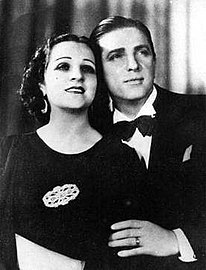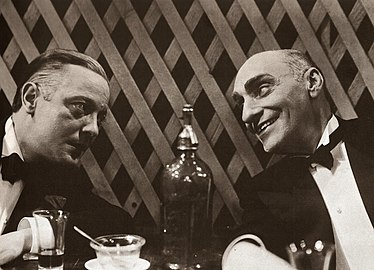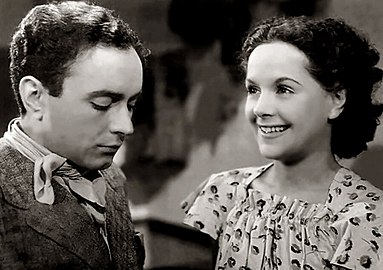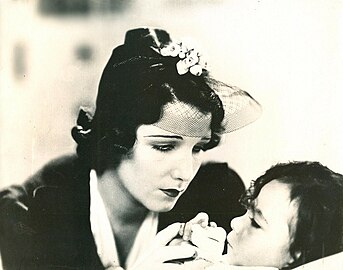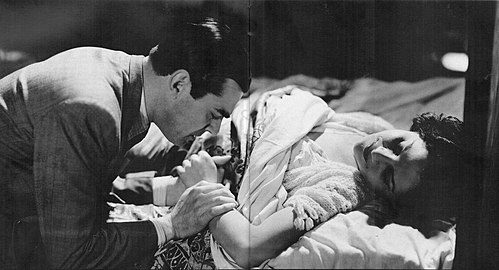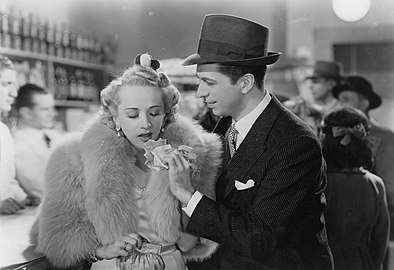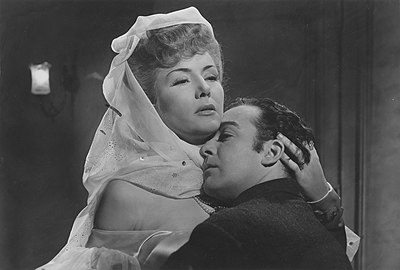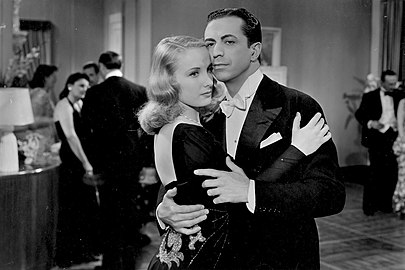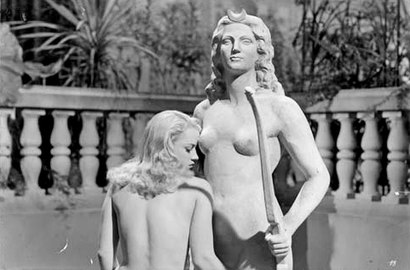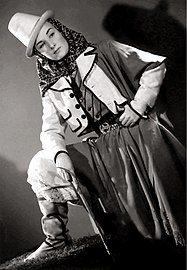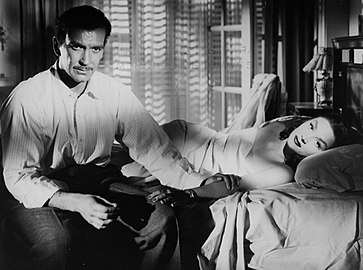User:Bleff/sandbox24
| Época or Edad de Oro del cine argentino ( European cinema |
The Golden Age of Argentine cinema (
Argentine industrial cinema arose in 1933 with the creation of its first and most prominent
Beginning in 1943, as a response to
The audience for early classical Argentine cinema were the urban
Background
1896–1928: The silent era
At the end of the 1900s, the incipient Argentine cinema made significant progress with the appearance of the first narrative films, which encouraged production and distribution.[32] These were the work of the Italian Mario Gallo, who had arrived in Buenos Aires a few years before as part of an opera company.[37] There is confusion as to which was the first narrative film in the country: those who date its release in 1908 consider it to be El fusilamiento de Dorrego,[36] while more recent researchers point out that this film is actually from 1910 and the first one was really La Revolución de Mayo, released in 1909.[38] For this reason, May 23 is considered National Film Day in the country, in commemoration of the release date of the latter film.[39] In the manner of the French film d'art trend, Gallo's films were closer to photographed theatre, almost always on historical topics.[36] In 1914, Glücksmann produced the oldest surviving feature film, Amalia, very similar in style to Gallo's films.[40] The film was an initiative of the Buenos Aires aristocracy, and premiered at the prestigious Teatro Colón with the attendance of President Victorino de la Plaza.[40] With the outbreak of World War I in 1914, European film production retreated, which resulted in an abundance of Argentine production in the following years.[41] As noted by Mahieu, during this time Argentine cinema "tends to abandon its character of empirical adventure, to become an entertainment industry. New distributors appeared, and in 1914 Pampa Film was founded, which produced several films."[42]
Before the arrival of sound films, Argentina experienced a "golden age" of silent films and led their production in Spanish, with more than 100 feature films being made between 1915 and 1924, equal to the combined total of those made in Mexico and Spain.
If anything characterizes Argentine silent cinema, even during its most prolific period, it is its dispersion and diversity. Instead of being concentrated in large companies, production appears atomized in dozens of independent enterprises, technically assisted by a relatively small number of specialists and laboratories (or "talleres" [workshops], in the terms of the time). This phenomenon explains its wide thematic variety and its singularities: in this mode of production, opposed by definition to the mass production favored by the big studios, the exception was the rule.[47]

In the early 1920s, Argentine silent cinema entered a crisis caused, on the one hand, by the recovery of European industry after the end of the war and, on the other hand, by the ascent of
The most complete form of the silent "tango melodrama" model was the work of
1929–1932: Transition to sound films

Around 1929, the inventor Alfredo Murúa—founder of Sociedad Impresora de Discos Electrofónicos (SIDE)—became a partner of the Ariel production company, and produced the short film Mosaico criollo, with his own sound-on-disc system.[59] Mosaico criollo, the first instalment of an intended series, is not a spoken film but rather a filmed "musical revue".[59] Murúa was responsible for the sound of most of the Argentine sound films made between 1931 and 1933, always using the sound-on-disc technique.[59] The most important was Muñequitas porteñas (1931) by Ferreyra, for its pioneering use of spoken dialogue, although there were several others that used it partially, such as Amanecer de una raza (1931) by Cominetti, El cantar de mi ciudad (1930) by Ferreyra or La vía de oro (1931) by Cominetti; or that used sound to record only music and sound effects, among them ¡Adiós Argentina! (1930) by Mario Parpagnoli, La canción del gaucho (1930) by Ferreyra or Dios y la patria (1931) by Cosimi.[59] It also happened that originally silent films were re-released with new sound added, as in the case of Nobleza Gaucha and Perdón, viejita, among others.[59] As noted by Fernando Martín Peña: "In this sense, the transition [from silent to sound films] was complex and very similar to that which had just taken place in the United States and Europe."[59]
As in other countries, the arrival of sound films put in check the international dominance of American cinema due to the language barrier, leaving a market available.
Despite being foreign productions, Gardel's films may be considered as part of the history of Argentine cinema, as they were conceived by the singer himself together with other Argentine artists (like his lyricist Alfredo Le Pera or revue producer Manuel Romero), and their model corresponded to that of the tango dramas directed by Ferreyra during the silent era, resulting in a strong Argentine identity.[59] In addition, their great commercial success demonstrated the commercial viability of a cinema of Argentine identity for the incipient local producers that would inaugurate the Golden Age period in 1933.[59][60] Paradoxically, Hollywood's attempt to dominate the local market would soon result in the birth of the national industry, which would take Gardel's films as a model to be replicated.[60] According to Peña, the success of Gardel's films was "in fact the success of Ferreyra's and Torres Ríos' ideas taken up by a popular idol and legitimized for the local culture because of their 'foreign' condition".[59] In an interview, Argentine film historian Clara Kriger felt that: "... we [Argentine film historians] always say 'in 1933 the industry was born in Argentina', and the truth is that I would say that until Gardel appeared in films, Argentine cinema practically did not exist on billboards; very little Argentine cinema was being seen. Gardel is what gives Argentine cinema that strength on the billboards."[61] Another aspect little mentioned by historians is that the last four Paramount productions with Gardel were in fact the singer and Le Pera's own productions that the studio agreed to finance, with full property rights for both creators after a first period of commercial exploitation.[59]
Development
1933–1935: Birth and growth of the industry
The year 1933 meant the beginning of an industrial organization in Argentine cinema due to the emergence of Argentina Sono Film and Lumiton—[15]—the first optical sound film studios in Latin America.[62] and the almost simultaneous release of their first productions ¡Tango! and Los tres berretines, respectively, the first feature films with optical sound in Argentine cinema.[63] According to Matthew B. Karush, the "growth of Argentine cinema resulted from the efforts of small entrepreneurs who proved adept at catering to local tastes", citing Angel Mentasti—founder of Argentina Sono Film—as a typical example.[64] Inspired by the Hollywood model, Mentasti introduced serial industrial production to local filmmaking,[65] and his plan consisted of "[forming] a company on the basis of three films and not release the first until the second had started and the third was announced."[66] The project was born after Luis Moglia Barth contacted Mentasti with the idea of producing a film entirely starring the popular performers of revue theater, tango and radio.[63] The duo secured financing from two different capitalists, which inspired them to create the company Argentina Sono Film and undertake serial production to give them a better chance of negotiating with distributors.[66] The musical ¡Tango! premiered on 27 April 1933 and attracted audiences for its select cast of popular performers, including Luis Sandrini, Azucena Maizani, Mercedes Simone, Libertad Lamarque, Pepe Arias and Tita Merello, among others.[67] While Tango! was being released, Argentina Sono Film was shooting its second film, Dancing (1933), which had little repercussion,[68] while the great success of the third film, Riachuelo (1934), allowed the economic viability of the studio.[69]

Lumiton was founded by César José Guerrico, Enrique Telémaco Susini, Miguel Mugica and Luis Romero Carranza, a group of well-off entrepreneurs who had been responsible for introducing radio to the country in 1920.[63][68] The group had traveled to Hollywood in 1931, where they studied the novelty of optical sound films and decided to bring the new technology to Argentina.[70] After purchasing a complete film equipment at Bell & Howell in Chicago, they returned to Buenos Aires and began building a studio in Munro, Buenos Aires Province, replicating the sound stages they had seen in Hollywood.[70] Thanks to the financial backing of its founding partners, Lumiton became a pioneer in the industrial and autonomous conceptualization of production.[71] The company brought in experienced technicians (including cinematographer John Alton) and opened its first film gallery in December 1932, beginning production with an adaptation of the successful play Los tres berretines.[63] Released on 19 May 1933,[72] the film's credits do not name the director, screenwriter or technical staff.[70] Although ¡Tango! is often considered the first success of classical Argentine cinema, research on the box offices of the time indicates that Los tres berretines had an even greater impact on audiences.[73] In both films, Sandrini plays an awkward, stuttering comic archetype that he had previously consecrated in the theatrical version of Los tres beretines.[74] With some variations, Sandrini played this character in the rest of his films of the decade, which established him as a star of humorous cinema in the Spanish-speaking world during the 1930s and early 1940s.[74]
The joint success of ¡Tango! and Los tres berretines confirmed the existence of a growing demand and led to the simultaneous appearance of several production companies eager to take advantage of the opportunity.
In addition to new production companies, the demand for Argentine films prompted the emergence of independent productions, that is, those that were made outside the studios.[75] However, Peña notes that the term "independent" for these films is actually a misnomer, as "this classification loses sight, for example, of the fact that in the early years of sound, Argentina Sono Film itself was not really a 'big studio' and could have disappeared like many other production companies of those years", and that "all ventures lacking significant financial backing (as only Lumiton had) were intensely dependent on commercial success and in this sense the mode of production remained, as in the silent period, atomized, adventurous, fragile."[75] Alton temporarily stepped away from Lumiton to make his own film, El hijo de papá (1933) starring Sandrini, which was such a failure that it caused the latter to set the film's negatives on fire.[75] Moglia Barth also decided to try independent production, moving away from Mentasti to make Picaflor (1935), although the following year he returned to Argentina Sono Film.[75] Also in 1933, the film El linyera directed by Enrique Larreta was released, which is considered more of a filmed theatrical piece than a cinematographic work.[79] The director who had the greatest success in independent filmmaking was Ferreyra, with three films released between 1934 and 1935: Calles de Buenos Aires, Puente Alsina and Mañana es domingo, all of them made with "very few resources but recovering the poetics of his best silent period."[75]

The new industry quickly gained traction and grew steadily over the next decade, despite the fact that Hollywood continued to have a vastly superior advantage over local producers.
1936–1942: The rise and fall of international dominance
The industrialization process was accompanied by
By 1937, there were 9 film studios and 30 production companies in Buenos Aires.[64] In 1938, 16 new directors debuted, most of them coming from the theater, including Caviglia, Alippi, Guibourg, Ivo Pelay, Coronatto Paz, Ernesto Vilches or Eduvaldo Viana, among others.[82]
In 1939, Argentina became the world's leading producer of Spanish-language films, with a new record of 50 feature films being made.[62]
| Graphs are unavailable due to technical issues. There is more info on industrialization in 1933, Argentine cinema grew exponentially and became the world leader for the production of films in Spanish by 1939.[13] This primacy ended abruptly in 1943, when the United States imposed a boycott on sales of film stock to the country and provided a series of benefits to the Mexican industry.[84]
The decline experienced by the Argentine industry compared to the Mexican industry is not attributed only to US intervention, but also to a series of defects in its commercial management.[85] The success of national cinema did not favor the industrial production sector so much as it did the commercial sector, that is, distributors and exhibitors.[86] As noted by José Agustín Mahieu, the growth of the industry "did not translate commercially into parallel income for production. With a suicidal improvisation, the directors of the industry delivered their films at a fixed price, so that the major profits produced by the eventual public successes remained in the hands of the distributors. The invested capital was thus subjected to limited, short-term plans."[87] In an article published on 29 July 1942 in Heraldo del Cinematografista, Luis Saslavsky pointed out these issues:
The cinema of Mexico, on the other hand, had begun to adopt a more favorable long-term policy for its development, through direct state management of production, distribution and exhibition companies, unlike the free market that reigned in Argentine cinema.[86] For example, since 1942 the country had the National Film Bank (Spanish: Banco Nacional Cinematográfico), which helped finance the productions.[88]
1943–1955: Industry crisis and protectionist measuresThroughout the 1930s, the Argentine state had remained largely on the sidelines of the development of the film industry. After the end of World War II, the United States maintained its raw film stock restrictions on Argentina.[91] A 1947 law mandated that domestic films constitute 25% of screen time in first-run porteño theaters and 40 percent elsewhere in the country.[90] Simultaneously, the Banco de Crédito Industrial initiated financing options for domestic film producers, while producers also received a substantial subsidy funded by a minor fee added to ticket prices.[92] Through the implementation of this law, the established legal and official parameters for the development of the Argentine film industry were set.[6] Although these measures didn't restore international sales, they successfully revitalized film production levels: in 1950, the industry released fifty-six films, finally reaching the peak it had attained in 1942.[92] Due to limited capitalization and the idiosyncrasies of Argentina's protectionist framework, there was a tendency to produce low-budget films.[92] These films, reliant on subsidies, were assured screen time irrespective of their quality.[92] The Peronist government actively pursued a moralizing and nationalistic agenda in the domestic cinema.[92] Films deemed to be "of national interest" were granted privileged access to government credit, and the government centralized the distribution of raw film stock, favoring specific producers.[92] By 1949, with the appointment of Raúl Alejandro Apold, former press chief for Argentina Sono Film, as the undersecretary of information and press, the regime had effectively shaped a film industry where every artistic decision fell under political control.[92] According to Valeria Manzano, the Peronist government "intervened in the film industry on two levels. On the one hand, by offering credits and different types of financing to some studios (...). On the other hand, (...) films were officially consecrated (through the annual awards granted by the film critics) that presumably carried a strong moral charge, reinforcing generic values such as solidarity, the maintenance of family unity, 'patriotism' and fundamentally pointed out 'binary' oppositions characteristic of the Peronist discourse: 'people/oligarchy' / 'lust/austerity', among others."[6] According to Kriger:
According to Peña:
1956–1960: AftermathThe only releases corresponded to films made the previous year.[93] HistoriographyThe first book dedicated to the history of Argentine cinema was Domingo Di Núbila's Historia del cine argentino, published between 1959 and 1960.[3] At that time, the idea of writing the history of the different regional cinemas arose in Latin America, inspired by the growing edition of books focused on the history and making of cinema in general.[3] http://www.adversus.org/indice/nro-26/dossier/XI2609.pdf Di Núbila's and Mahieu's books became foundational reference texts for subsequent historical studies of Argentine cinema.[3]
http://repositoriouba.sisbi.uba.ar/gsdl/cgi-bin/library.cgi?a=d&c=telonde&d=5102_oai
Di Núbila (1959), Mahieu (1966), Dos Santos (1971), Posadas (1973), Couselo et al. (1984). Todos ellos, en mayor o menor medida, pueden detenerse sobre los géneros y la edificación de una industria nacional, pero sobrevuelan, por ejemplo, las pertinencias textuales de los sistemas narrativos que les son propios, la evidencia o no de los mecanismos enunciativos o, sencillamente, alguno de ellos acusa su deliberada tendencia política, tiñendo sus argumentaciones de indudables cuestionamientos razonables. En última instancia, se trata de textos que, o bien por su marcado registro historicista o por la época y las circunstancias en las que fueron escritos, no postulan, claro está, la historia del cine como la de la evolución del lenguaje cinematográfico concomitante con la evolución de la industria, los géneros y el contexto sociocultural específico.[94] Style and themes1933–1938: Tango and working-class cultureGenerally speaking, the Argentine cinema of the 1930s was characterized by a deliberate effort to portray the working classes, which, in turn, emerged as its main consumers.[28] The so-called tango melodrama (Spanish: melodrama tanguero) became the first defined genre in the Argentine cinema of the classic-industrial period.[95][96] This style had its antecedents in the silent films of the 1920s, especially in the work of José A. Ferreyra, focused on portraying the world and characters associated with tango, a genre linked to the lower-class neighborhoods of Buenos Aires.[55] Peña noted that, although in terms of production the Argentine industry wanted to resemble that of the US and France, it "owes less to these other cinematographies than to its strong links with tango, radio or revue, forms of popular art from which many of its main performers, directors and screenwriters came. These roots not only conditioned a certain aesthetic in a particular way, but also the configuration of the various genres, which are almost always hybrids."[9] As noted by Karush:
Unlike Hollywood cinema, Argentine industrial cinema was slow to structure its production in the well-defined matrices of film genres.[98] The first film genre of Argentine cinema consisted of a "sentimental narrative structure originated in the tango".[96] The first Argentine sound cinema was strongly linked to the theater, which was reflected in their staging and acting style.[99] For example, in early films like ¡Tango!, Radio bar or Por buen camino, the "actors speak, move and gesticulate as if they were on a theatrical stage. The camera was limited to capturing those gestures and attitudes (which today seem excessive or exaggerated), often in fixed general shots, so that the actors could move without risk of going out of frame."[99] Some critics, such as Domingo Di Núbila, identified these "narrative weaknesses" in terms of "backwardness" in relation to the cinema of other countries.[99] On the other hand, writer Mario Berard suggests that it was actually a moment of "creative freedom", in which filmmakers "made use of the impunity of the 'no one knows' to freely appropriate the resources of the new medium. On the contrary, in the 40s and 50s, filmmakers submitted to the canons of the industry, giving rise to a homogeneous and strongly structured mode of representation."[100] According to Ricardo García Oliveri, the directors of the early sound period "have in common the intuition, the enthusiasm and the sense of the popular. These directors generally come from the middle class and they all coincide, at this stage, in a naive cinema, considered ordinary by the upper classes and hardly costumbrist by the aesthetes, but with virtues that are not harmed by its eminently local content."[24]
The tendency of these early sound movies to emphasize and celebrate the cultural practices of ordinary Argentines Gardel influence: "Paramount's success with Gardel showed Argentine filmmakers that they could compete with Hollywood by emphasizing their own authenticity. Argentine movies could speak to local audiences in a way that Hollywood films could not. They were set in familiar locales, and they starred actors who spoke Spanish in the local dialect and who were often recognizable to filmgoers from their previous careers in theater and radio. Moreover, these films drew their material from Argentina's popular cultural traditions."[60] https://rephip.unr.edu.ar/handle/2133/15923 https://www.revistas.usp.br/significacao/article/view/134850/136940
As noted by Karush: "Domestic filmmakers benefited from the long tradition of popular theater in Argentina, particularly the short comic plays known as sainetes; by providing comparable entertainment at a lower admission price, they could capture an already existing audience."[60] https://books.google.com.ar/books?id=M8TzCQAAQBAJ&source=gbs_navlinks_s https://books.google.com.ar/books?id=mphsR8d-ZagC&pg=PA391 1939–1945: Turn to bourgueois topics The premiere on July 19, 1939, of Así es la vida, directed by Francisco Mugica and produced by Lumiton, marked a turning point for the themes, stars, directors, and representation universes in Argentine cinema.[28] For the first time, the ascending middle class and the bourgeoisie emerged as protagonists who elicited empathy and identification from the audience, in contrast to previous cinema that criticized and portrayed the upper classes as villains.[28] Unlike the ruling clases depicted in Manuel Romero's films, associated with the imagery of an elite land-owning oligarchy, the protagonists of Así es la vida belong to an industrial and professional bourgeoisie, something that promoted ideas of social ascent and appealed to the middle classes, through its celebration of hard work and family unity.[28] The film did not target differentiated audiences but encompassed both lower and middle to upper-class sectors, allowing identification for the latter while also shaping specific imaginations and aspirations; by integrating modernity into the national reality, it reconciled both factors through the exaltation of the family as a point of balance.[28] The box-office and critical success of Así es la vida led to the proliferation of films that sought to imitate its style, such as Alberto de Zavalía's Dama de compañía, Luis Bayón Herrera's Mi fortuna por un nieto and Francisco Mugica's Medio millón por una mujer, all of them premiering in 1940.[28] However, none of these productions managed to replicate the success of Así es la vida, and debates persisted in the specialized press regarding the need to renew Argentine cinema without alienating the working classes.[28] These debates and problems seemed to be settled with the premiere of Mugica's Los martes, orquídeas on June 4, 1941, which was a success with both the public and critics, and opened the doors to a new style that would enjoy great success during the 1940s: that of the so-called bourgeois comedy (Spanish: comedia burguesa).[28] In particular, the film was the initiator and main exponent of the cine de ingenuas (roughly translated to "ingénue cinema"), the first dominant model adopted by bourgeois comedy.[28] Although it has often been underestimated by historians, the cine de ingenuas was a genre of great relevance in Argentine cinema between 1941 and 1945, reaching 20% of national film production in 1942.[28] The style was defined
Trying to maintain its position and gain more markets, post-war Argentine cinema resorted to less local language and international stories.[24] 1946–1956: During the Peronist eraContinuing the pattern that emerged in the early 1940s, Argentine cinema of the Peronist era predominantly focused on the comedy genre.[6] Mahieu described the period as the "rise of the falsely international, hybrid cinema, the pink comedy, the hollow melodrama", although he commended the "isolated exceptions" of Pelota de trapo (1948), El crimen de Oribe (1950), Días de odio (1954) and Las aguas bajan turbias (1952).[93] According to Peña, the "tendency of Argentine cinema to adapt foreign authors and works began timidly at the end of the 1930s and grew stronger until it reached delirious extremes ten years later. The obvious cultural affinities made the approach to Spanish or even Italian works more or less logical, but regardless of the geographical origin of the material, the problem was rather the criterion of the producers when choosing and conceiving their adaptation." Although there were no explicitly propagandistic narrative films, elements of the official Peronist discourse were reflected in the contents of the cinema of the time.[61] Researcher Valeria Manzano recognizes several elements of Peronist morality in the films of the period: "the preservation of the constituted home, class solidarity and the honoring of work as a value essentially involved in the 'march' of society as a whole."[6] The new class of the industrial "nouveau riche" was brought to the screen, contrasting them with "old money" industrialists.[6] In a parodic tone, these "new industrialists" are presented as oscillating, on the one hand, between the excessive luxury of their newly acquired wealth and, on the other, the imitation of old social patterns.[6] As noted by Manzano:
On the other hand, Manzano focuses on the type of comedies starring Niní Marshall and Luis Sandrini, in which conflicts are resolved by tapping into a kind of "popular common sense".[6] These films often tell stories of low-skilled workers who dream of climbing a bit higher on the social ladder to a comfortable middle-class.[6] In these productions, there's a recurring theme of accepting class differences, especially in Manuel Romero films like Navidad de los pobres (1947).[6] Manzano writes: "The class society of Peronism coexists in the universe of the comedies: the classes share a code and a conflict, the relationships are friendly and pleasant, but the assigned places are never, ever subverted."[6] The other discursive axis that runs through the comedies of the period is a type of work ethic that is opposed to "corruption" and "idleness".[6] Manzano cites the films of comedy actor Pepe Arias as an example, in which his character "usually begins by dreaming of being able to escape the harshness of work and takes on a thousand characters to achieve it."[6] Between the late 1940s and the 1950s, film noir (Spanish: cine negro) emerged as one of the main genres in Argentine cinema with the work of directors such as Daniel Tinayre, Carlos Hugo Christensen, Hugo del Carril, Hugo Fregonese, Don Napy and Román Viñoly Barreto, among others.[104] LegacyConservation
— Martín Miguel Pereira, Imagofagia, 2015.[105] Many films survive but through incomplete copies, missing scenes or musical numbers, as is the case with Unlike most countries, Argentina has not adopted public policies that preserve the national film heritage, which has been a long-standing claim by the film-related community.[107] This has led to the loss of a large amount of material and to the fact that of many films only a single copy survives in a poor condition, even some that are considered among the most important in Argentine cinema by critics and specialists.[105] From the beginning, the film industry was built around continuous production, with little interest in retaining material already released. As noted by Martín Miguel Pereira:
Between the late 1930s and mid-1940s, there were some first measures for the conservation of film material, although they were interested in the documentary record rather than fiction films. Museums Critics' listsPrisioneros de la tierra (1939) by Mario Soffici , which has been considered the greatest Argentine film of all time on several occasions.Several films from the classical period have been listed among the best in the history of Argentine cinema. The Museo del Cine Pablo Ducrós Hicken carried out polls to determine the greatest Argentine films of all time in the years 1977, 1984, 1991 and 2000.[108] The results of the 2000 poll can be found in the 4th issue of La mirada cautiva, the museum's magazine, which also included the top 10 from the 1977 and 1984 polls.[109] In the 1977 list, 8 of the top 10 results were films released before 1957, including Prisioneros de la tierra (1st place), La guerra gaucha (3rd place), Así es la vida (4th place), La vuelta al nido (5th place), Las aguas bajan turbias (6th place), La dama duende (7th place), Malambo (8th place) and Fuera de la ley (10th place).[109] In the 1984 list, Prisioneros de la tierra was again selected as the greatest film of Argentine cinema, although only three other pre-1957 films reached the top 10: La guerra gaucha, Las aguas bajan turbias and Los isleros.[109] Due to the coincidences in the number of votes, the top 100 list of the 2000 poll resulted in 43 positions comprising 101 films, of which 29 were released before 1957; these are:[109]
In 2022, the film magazines La vida útil, Taipei and La tierra quema carried out a new top 100 list inspired by the previous ones, which was presented at the Mar del Plata International Film Festival.[110] Due to the coincidences in the number of votes, the total list includes 812 titles and 62 ranking positions,[108] while the "top 100" includes places from 1 to 52 and comprises 103 films.[111] For the first time, no pre-1960s film appeared in the top 10,[112] and classical-era films were among those that decreased the most compared to the previous poll.[108] The fact that more than a third of the list corresponds to films released in 2000 onwards has been interpreted as a consequence of the absence of conservation policies for the country's film heritage.[108][113] As such, the results of the 2022 poll fueled the long-standing claim for the need for a national cinematheque.[114] The films prior to 1957 that made ir to the top 100 of 2022 were:[111]
In 2000, Major figuresActors
DirectorsUnlike the silent era, there were no female directors during the classical period because the industry firmly prevented their emergence, and the first sound film directed by a woman did not come until 1960 with Vlasta Lah's Las furias.[47]
Lists of films
Image gallery
See also
NotesFootnotes
References
Bibliography
Further reading
External links
|






